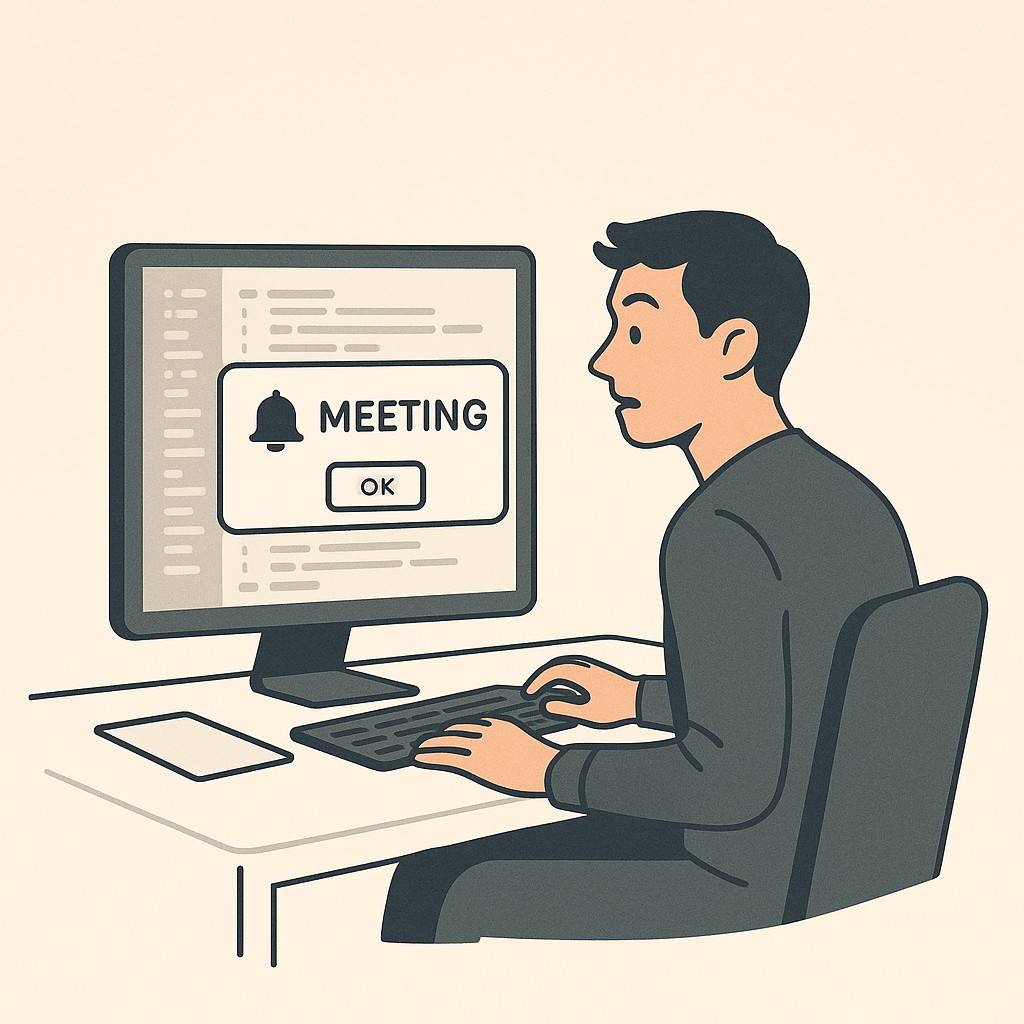Reduce Meetings for Engineers: Attend Only When Your Live Input Is Essential
Reduce Meetings for Engineers: Attend Only When Your Live Input Is Essential

Reduce Meetings for Engineers: Where I Draw the Line
The shift started after I reread Justin’s post on controlling time. Comparing my calendar with how I actually worked, I could see something off. Most of my meeting acceptances were about optics, not impact. The uncomfortable part—I’d known this for a while but seeing it spelled out was the push I needed.
Here’s the first real boundary. Reduce meetings for engineers by stopping the reflexive yes to every invite. You don’t have to.
Of course, that’s a powerful idea, but also a tricky one. How do you actually say no to meetings without looking checked out or, worse, not a “team player”? The pressure to keep up appearances is real. If you’re worried about the optics, you’re not alone.
I switched tactics. Before I accept an invite, I ask for a concrete agenda and what exact input they need from me—preferably in writing. Sometimes it’s an email, other times it’s a short doc or a quick video clip. When it turns out my synchronous presence isn’t essential, I add my notes asynchronously and keep my calendar clear for deep work.
Here’s the plain thesis. I only attend if my unique input is needed live. Otherwise, I contribute asynchronously and move on.
The Hidden Cost of Meetings
There’s this thing that happens under meeting overload for engineers: you’re settling in to do real work—a block of time you’ve actually protected—and then, ping, a meeting pops up. It might only be thirty minutes, but the true cost isn’t obvious. You lose your train of thought. Your brain drops what it’s doing, jumps to something else, and then you have to somehow pick back up where you left off. Losing momentum to interruptions isn’t trivial. Task switching costs us around 25 minutes and leads to bouncing between an average of 2.3 other tasks before we find our way back. That means one “quick” sync can quietly blow a whole afternoon of flow.

Somewhere along the way, we absorbed the idea that being present in meetings equals being valuable. But contribution isn’t measured by time-in-meeting. It’s measured by shipped outcomes. Some of the top tech companies push for fewer meetings for developers, aiming for roughly 70% of their time on real coding and inner-loop work, not just meetings.
Deep work is pretty simple at its core. The more uninterrupted space you have, the better you’re able to carry mental state from one session to the next. Retained state means you remember exactly why you made a technical decision, or what that last TODO in the codebase was about. Fewer interrupts—not just in quantity but in randomness—means you can actually solve gnarly problems end-to-end, not in scattered, reactive bursts. I’ve found that my iterations get tighter, feedback loops shorten, and I actually notice when my thinking levels up. It’s not just about output in terms of lines of code or shipped features. It’s the difference between patchwork solutions and those rare, high-leverage improvements you only get when you’re left alone long enough to see the system as a whole.
Over time, I realized that skipping meetings wasn’t about avoidance. It was about adding value in smarter ways. The difference is not subtle. Once you internalize this, saying no doesn’t feel like a risk. It feels like working with intention.
You can’t control every demand for your time, but you can force clarity on the purpose of a meeting and which channel actually makes sense. When you ask, “Is this the best way for me to help?”—and sometimes insist on a written reason—you raise the bar for collaboration and protect precious focus. Your impact compounds not just because you’re present less, but because the work you do when you’re present is that much higher quality.
Messy moment: I once tried to eliminate every single meeting for a week, just to see what would happen. I thought I’d land in hot water, but what actually happened felt even weirder. Nobody seemed to notice except one person, who sent me a DM on Tuesday afternoon asking if I was “still around.” The joke was on me—I’d spent more time checking Slack than actually building anything. Turns out, skipping meetings isn’t just about saying no. It’s about using that reclaimed time well, otherwise the “free” hours get filled by something equally distracting.
Deciding When to Join, and How to Defend Deep Work
Six months ago, I would have accepted almost every invite without a second thought. Now, to reduce meetings for engineers, before accepting a meeting I take a beat and ask for the agenda plus the exact decision or input they need from me. The reality is half the meetings we join are rated “poor,” and US organizations lose $213 billion annually to bad meetings, according to Quartz. So a strong pre-check isn’t optional anymore.
Next, I run a brutally simple decision test. Is my unique, synchronous input essential to unblock a decision or reduce risk right now? Not just “is it helpful,” but “will it stall without me, live?” If it isn’t clear why your presence changes the outcome, you’re probably safe to skip or at least to contribute in a lower-friction way. Sometimes what really matters is the thinking, not the attendance.
If attendance isn’t essential, replace meetings with async by picking the lowest-overhead channel and contributing there. An email with bullet points, a comment in the shared document, or a quick video walkthrough if nuance warrants it. You don’t need to be on the call to add real value.
Then comes the part most people skip: actually blocking off time for deep work, with the same seriousness you’d give a client call or a launch. Put it on your calendar—labeled as “deep work,” “focus time,” or whatever feels least likely to get trampled. Treat those blocks as mission-critical meetings with yourself. If someone tries to book over them, defend them openly. “I’ve protected this time for core deliverables.” At first, it feels awkward, but people learn quickly to respect it when you’re explicit. Callback to the earlier point about protecting a block of time—this is the moment where impact compounds, not just for you but for everyone who gets sharper work.
Finally, don’t just vanish after declining. When you contribute asynchronously, close the loop by following up with a short summary—email, doc note, whatever—so decisions actually move forward. This makes your absence feel less like a gap and more like built-in leverage. You keep momentum without sacrificing presence.
My unresolved tension? Even now, every once in a while, I catch myself RSVP-ing yes out of habit. I know I’m supposed to guard my time—still, some invites slip through. Old habits, maybe. Haven’t fully cracked that one.
Tactful Scripts: Clarity Without Burnout
The agenda request comes first, always. If you get a meeting invite, reply with something like, “Can you clarify what decisions or input you’re hoping to get from me? If there’s a written agenda or doc, could you share it?” You can add, “If there’s specific context, I’m happy to review and comment asynchronously, just let me know timing.” This isn’t nitpicking; it’s about making it easy for everyone to see if a meeting really needs to happen. Framing cuts down the back-and-forth cycle, which frees up heads-down time and actually moves work forward.
Sometimes you worry—will saying no this way make you look stand-offish? It actually does the opposite if you handle it right. Emphasizing outcomes (“I’ll turn around feedback by end of day Thursday”) and sharing a clear deliverable signal that you aren’t dodging; you’re just focused on results. Most folks respect a clear line when it’s tied to moving the work forward, especially if you specify when you’re free for truly urgent syncs.
Quick aside. This is all about picking the right tool for the job. I wouldn’t brew a pour-over if I just needed caffeine—only when I really want to taste what’s different. Meetings should be the same. Reserve live time for moments when conversation can’t be replaced by a written doc or threaded comment.
If you’re worried about disappearing from view, keep visibility high without showing up everywhere. Post a weekly update in Slack, comment in design docs, or drop a concise note in a code review. It’s just as clear you’re adding value—without burning your calendar down in the process.
Your Move: Turn Insight Into Action
Your Move: This week, audit your calendar. Pick one meeting and ask yourself: What value can I add asynchronously? Like or comment below with your best tips for tactfully declining unwanted invites. What’s worked for you?
Here’s a thing I wish I’d known years ago. You’ll miss less context than you fear, and what you gain in clarity pays off fast. When I first started skipping meetings, I was convinced I’d lose threads or quietly fade out of decisions—I didn’t. What actually happened is the friction dropped away, and my output (actual shipped work, not just busywork) ramped up. If anything, I found that cutting the sync habit surfaced a lot more actionable feedback and made it obvious what was noise. Or, as a small bonus, my follow-ups got sharper because I wasn’t juggling half-remembered details between calls. You really do end up shipping more with less mental clutter.
Protect your deep work blocks by contributing asynchronously with sharp notes, agendas, and weekly updates; use our AI to draft clear, on-point content in minutes when you need it.
Protecting deep work and choosing the right channel isn’t just a productivity hack. It’s a system for freeing you to focus on what truly matters.
Enjoyed this post? For more insights on engineering leadership, mindful productivity, and navigating the modern workday, follow me on LinkedIn to stay inspired and join the conversation.
You can also view and comment on the original post here .
